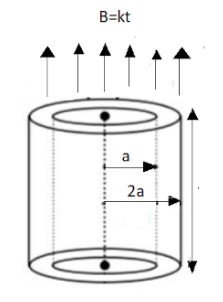
A ring of circular cross section is made up of material of resistivity $ \rho $ . The inner and outer radii of ring are $ a $ and $ 2a $ and its thickness is $ h $ , The ring is placed in a varying magnetic field $ B = kt $ (where $ k $ is a constant )which is parallel to the axis of the ring as shown in the figure . The induced current in the ring is :
$ \left( A \right)\dfrac{{3kh{a^2}}}{{4\rho }} \\
\left( B \right)\dfrac{{3kh{a^2}}}{{2\rho }} \\
\left( C \right)\dfrac{{5kh{a^2}}}{{4\rho }} \\
\left( D \right)\dfrac{{5kh{a^2}}}{{2\rho }} \\ $


Answer
525.3k+ views
Hint : In order to solve this question, we are going to first find the flux related to the ring of radius lying between the two radii, then from flux, the emf can be found very easily. Then, by finding the resistance from resistivity and the area and length, the total induced current can be calculated.
The flux related to a ring is given by
$ \phi = BdA $
Emf is given by
$ emf = \dfrac{{d\phi }}{{dt}} $
Complete Step By Step Answer:
Let us consider a hypothetical ring of radius $ r $ that exists in between the rings of radii $ a $ and $ 2a $ ,
The flux related to this ring is given by
$ \phi = BdA $
Putting the values of the magnetic field as given in the question and the area, we get,
$ \phi = kt \times \pi hdr $
Now as we know that the emf is defined as the rate of change of flux per unit time, i.e.,
Mathematically,
$ emf = \dfrac{{d\phi }}{{dt}} = \dfrac{d}{{dt}}\left( {\pi kt hdr} \right) $
On solving this equation, further, we get,
$ emf = \pi khdr $
Now, in order to find the current, we need two quantities emf and resistance, thus, the current is
calculated as
$ i = \dfrac{{emf}}{R} $
Where, $ R = \dfrac{{\rho dr}}{{\pi rdr}} = \dfrac{\rho }{{\pi r}} $
Thus,
$ i = \dfrac{{\pi khdr}}{{\dfrac{\rho }{{\pi r}}}} = \dfrac{{4{\pi ^2}kh\int_a^b {rdr} }}{\rho } $
On solving the integral, we get
$ i = \dfrac{{{\pi ^2}kh\left( {4{a^2} - {a^2}} \right)}}{{2\rho }} \\
\Rightarrow i = \dfrac{{3{\pi ^2}kh{a^2}}}{{2\rho }} \\ $
Note :
It is to be noted that the flux that is found for a ring of the radius lying between the two radii, is the same for the total flux too and the resistance is found for the whole ring at once. The emf that is calculated gives the induced emf from the whole surface area from which the magnetic field lines are passing.
The flux related to a ring is given by
$ \phi = BdA $
Emf is given by
$ emf = \dfrac{{d\phi }}{{dt}} $
Complete Step By Step Answer:
Let us consider a hypothetical ring of radius $ r $ that exists in between the rings of radii $ a $ and $ 2a $ ,
The flux related to this ring is given by
$ \phi = BdA $
Putting the values of the magnetic field as given in the question and the area, we get,
$ \phi = kt \times \pi hdr $
Now as we know that the emf is defined as the rate of change of flux per unit time, i.e.,
Mathematically,
$ emf = \dfrac{{d\phi }}{{dt}} = \dfrac{d}{{dt}}\left( {\pi kt hdr} \right) $
On solving this equation, further, we get,
$ emf = \pi khdr $
Now, in order to find the current, we need two quantities emf and resistance, thus, the current is
calculated as
$ i = \dfrac{{emf}}{R} $
Where, $ R = \dfrac{{\rho dr}}{{\pi rdr}} = \dfrac{\rho }{{\pi r}} $
Thus,
$ i = \dfrac{{\pi khdr}}{{\dfrac{\rho }{{\pi r}}}} = \dfrac{{4{\pi ^2}kh\int_a^b {rdr} }}{\rho } $
On solving the integral, we get
$ i = \dfrac{{{\pi ^2}kh\left( {4{a^2} - {a^2}} \right)}}{{2\rho }} \\
\Rightarrow i = \dfrac{{3{\pi ^2}kh{a^2}}}{{2\rho }} \\ $
Note :
It is to be noted that the flux that is found for a ring of the radius lying between the two radii, is the same for the total flux too and the resistance is found for the whole ring at once. The emf that is calculated gives the induced emf from the whole surface area from which the magnetic field lines are passing.
Recently Updated Pages
A man running at a speed 5 ms is viewed in the side class 12 physics CBSE

The number of solutions in x in 02pi for which sqrt class 12 maths CBSE

State and explain Hardy Weinbergs Principle class 12 biology CBSE

Write any two methods of preparation of phenol Give class 12 chemistry CBSE

Which of the following statements is wrong a Amnion class 12 biology CBSE

Differentiate between action potential and resting class 12 biology CBSE

Trending doubts
What are the major means of transport Explain each class 12 social science CBSE

Which are the Top 10 Largest Countries of the World?

Draw a labelled sketch of the human eye class 12 physics CBSE

How much time does it take to bleed after eating p class 12 biology CBSE

Explain sex determination in humans with line diag class 12 biology CBSE

Explain sex determination in humans with the help of class 12 biology CBSE




